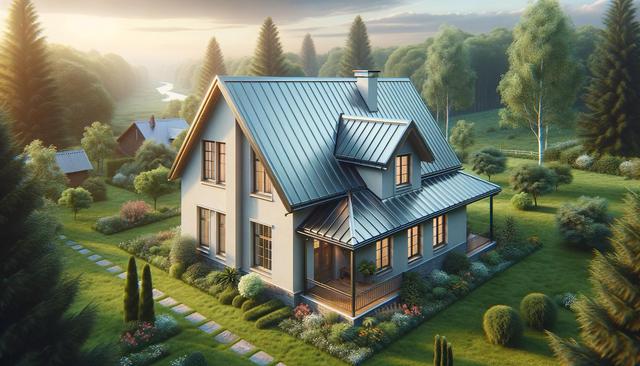
A Guide to Upgrade to a Durable, Long-Lasting Metal Roofing Solution
Why Choose Metal Roofing for Your Home
Metal roofing has gained popularity among homeowners due to its excellent durability and long lifespan. Unlike traditional roofing materials that may deteriorate over time, metal roofs can last upwards of 40 to 70 years with proper maintenance. This makes them a strong contender for those looking to upgrade from asphalt shingles or wooden shakes. One of the most appealing aspects of metal roofing is its resistance to elements such as wind, rain, snow, and even fire. These characteristics make it particularly suitable for regions with extreme weather patterns.
Another reason homeowners consider metal roofing is the low maintenance it requires. Once installed, these roofs generally need minimal upkeep compared to other materials. They are less prone to issues like mold, rot, or insect damage. Additionally, metal roofing is environmentally friendly, often made from recycled materials and fully recyclable at the end of its life cycle. For anyone considering a home upgrade, these benefits can translate into long-term savings and a smaller environmental footprint.
Types of Metal Roofing Materials
Choosing the right metal roofing material is essential for ensuring longevity and performance. Several types are commonly used in residential settings, each with its own advantages and price points. The most widely used materials include:
- Steel: Often galvanized or coated for rust resistance, steel is a strong and affordable option.
- Aluminum: Lightweight and corrosion-resistant, ideal for coastal areas with salty air.
- Copper: Offers a unique aesthetic and develops a natural patina over time, though it comes at a higher cost.
- Zinc: Known for its self-healing properties and durability, often used in architectural applications.
Each of these metals can be formed into different styles, including standing seam panels, shingles, and tiles, allowing for flexibility in design and function. When selecting a material, consider factors such as climate, budget, and desired aesthetics. Consulting with a professional roofing contractor can also help in making an informed decision based on your home’s specific needs.
Benefits of Metal Roofing Beyond Durability
While durability is a primary selling point, metal roofing also offers several additional advantages that enhance the overall value of your home. One of the most notable is energy efficiency. Metal roofs reflect solar heat, which can reduce cooling costs in warmer climates. Some coatings can even increase this reflective quality, making the home more comfortable during hot seasons. In colder climates, metal roofs help with snow shedding, reducing the weight load and risk of water damage from ice dams.
Another benefit is the variety of finishes and colors available. Homeowners can choose from matte, gloss, or textured finishes to complement their exterior design. These finishes not only add to the visual appeal but also provide extra protection against UV rays and corrosion. Additionally, metal roofs are known for their fire resistance, earning them high safety ratings in many areas. This is particularly important in regions prone to wildfires, where roofing material can make a significant difference in property protection.
Installation Considerations and Professional Help
Proper installation is crucial to maximizing the lifespan and performance of a metal roofing system. Unlike traditional roofing, installing metal panels or shingles requires specific tools and expertise. This is why hiring a qualified contractor with experience in metal roofing is highly recommended. A professional will ensure that flashing, fasteners, and underlayment are all correctly applied, preventing potential issues like leaks or wind uplift.
Before installation begins, it’s important to assess the structural integrity of your home. Metal roofs are generally lightweight, but if you’re replacing a heavier roofing material, your structure might need reinforcement. Additionally, consider whether your roof has complex angles or features like skylights or chimneys, as these can complicate the installation process. Your contractor should conduct a thorough inspection and provide a detailed plan outlining each phase of the project.
Maintenance and Long-Term Performance
One of the reasons homeowners opt for metal roofing is the ease of maintenance. However, a few routine checks can help ensure the roof continues to perform optimally over the years. These include:
- Inspecting for loose fasteners or panels after major storms
- Cleaning debris from gutters and roof surfaces regularly
- Checking for signs of corrosion or finish wear
- Ensuring that flashings and sealants remain intact
Most metal roofs come with manufacturer warranties that cover issues like paint fading or material defects for 20 to 50 years. Keeping a maintenance log and scheduling periodic professional inspections can help preserve these warranties. In the long run, investing a little time in upkeep can significantly extend the life of your roof and protect your home’s value.
Conclusion: Making the Smart Move to Metal Roofing
Upgrading to a metal roof is a practical, forward-thinking decision for homeowners who value durability, safety, and energy efficiency. With a range of materials and finishes available, it’s easier than ever to find a solution that fits your home’s style and performance needs. While the initial investment may be higher than traditional roofing, the long-term savings and reduced maintenance make it a worthwhile choice. By understanding your options and working with experienced professionals, you can ensure a successful upgrade that adds value and peace of mind for decades to come.


